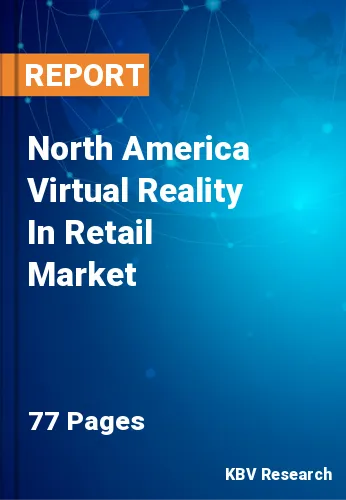The North America Virtual Reality In Retail Market would witness market growth of 26.0% CAGR during the forecast period (2023-2030).
A rapid market expansion is anticipated throughout the forecast period because of the growing trend of VR headsets in the retail sector, which is changing the way customers purchase. Furthermore, a number of companies are seeking to integrate VR shopping into their physical location and website to improve the consumer purchasing experience. The retail industry is changing due to virtual reality, which improves customer experiences and gets above physical limits. Customers may view things in 3D, visually try them on, and explore authentic surroundings because of VR's immersive and engaging shopping experiences.
With the help of this technology, retailers may present their entire product line in a virtual store, easing up physical space and inventory restrictions. The outcome is a convenient and engaging shopping experience that boosts client satisfaction & loyalty and encourages the use of virtual reality in retail. Additional factors include adopting and integrating artificial intelligence (AI), machine learning, and the Internet of Things (IoT) into virtual reality. The organization utilizes these technologies to modify its business. This is anticipated to drive the growth of the market.
The Mexican Online Sales Association reports that in 2021, the domestic eCommerce market was valued at USD 19.7 billion, a 27% increase over 2020. In 2021, there were 57.5 million users of Mexican eCommerce, up 11% from the previous year. In 2020, women made up 51% of Mexican eCommerce users. Based on experts’ estimations, due to improved financial inclusion, streamlined logistics, and elevated digital literacy, Mexico will have around 77.9 million eCommerce consumers by 2025. This region's market is expected to develop as e-commerce becomes increasingly popular.
The US market dominated the North America Virtual Reality In Retail Market by Country in 2022, and would continue to be a dominant market till 2030; thereby, achieving a market value of $3,963.5 million by 2030. The Canada market is poised to grow at a CAGR of 28.9% during (2023 - 2030). Additionally, The Mexico market would witness a CAGR of 27.8% during (2023 - 2030).
Based on Application, the market is segmented into Advertising & Marketing, Try-on Solutions, Planning & Designing and Information Systems. Based on Component, the market is segmented into Hardware, Software and Services. Based on Device, the market is segmented into Head Mounted Devices, Gesture Tracking Device and Projectors & Display Wall. Based on Vertical, the market is segmented into Clothing, Consumer Electronics, Food & Beverages and Home Products. Based on countries, the market is segmented into U.S., Mexico, Canada, and Rest of North America.
Free Valuable Insights: The Worldwide Virtual Reality In Retail Market is Projected to reach USD 20.4 Billion by 2030, at a CAGR of 26.9%
The market research report covers the analysis of key stake holders of the market. Key companies profiled in the report include Matterport, Inc., Scapic Innovations Private Limited (Flipkart Pvt. Ltd,) (Walmart Inc.), FXGear, Inc., Visualise Creative Limited, Panedia Pty Ltd., FireBird VR, KonceptVR LLC, WeMakeVR, Fiebak Medien, and Subvrsive, Inc.
By Application
By Component
By Device
By Vertical
By Country
Our team of dedicated experts can provide you with attractive expansion opportunities for your business.

